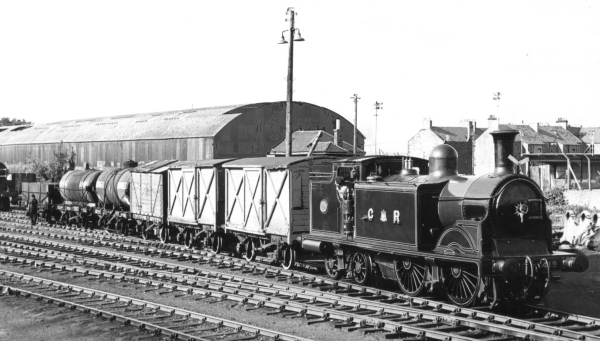

 |
| No.419 shunting at the SRPS Depot, Springfield Yard, Falkirk, 1970s. Photo D.S.G. Stirling |
Caledonian Railway No.419 is a member of the “439” class, designed by J.F.McIntosh. Ninety-two engines of this type were built between 1900 and 1925, most of them at the company’s St Rollox works in Glasgow. They saw duty all over the Caledonian system, on suburban passenger trains, branch line work, train banking duties and shunting. No.419 was built at St Rollox in 1907.
The arrangement of four driving wheels and a four wheel trailing bogie (an arrangement described by the American Whyte notation as “0-4-4”) gave these locomotives a short rigid wheelbase which helped them negotiate tight curves. For a tank engine, the driving wheels are large diameter – 5ft 9ins (1.75m). As a result, the locomotive travels further for every revolution, and so these locomotives had a good turn of speed. The two steam cylinders are as large as can be accommodated between the locomotive frames. Their size ensured that these locomotives could develop adequate power, and their position inside the frames, in preference to outside, reduced the twisting couple created by the connecting rod forces so that these were smooth running locomotives.
To work its trains, the Caledonian Railway adopted the air brake invented by the American George Westinghouse in 1869. This kind of brake, now used by railways everywhere, is worked by compressed air. The brake must fail safe (i.e. it must automatically apply in the event of a failure). So that each vehicle in a train has air available to operate the brake in an emergency, each carries an auxiliary air tank, and it is air from this tank that is admitted to the brake cylinders. This leads to the difficulty that the air available is limited by the size of the tank, and if the brake is released and reapplied in close succession, without the auxiliary tank having had time to recharge, the brake force will be lost. To avoid this difficulty, drivers used a technique of applying the brake with increasing force, without release, up to the point where the train stopped.
These locomotives were thus ideal for suburban passenger work – their large wheels ensured that they could accelerate fast from station stops, and the air brake ensured that they stopped rapidly as well.
No.419 still has its original air brake fittings. When the LMS railway (successor to the Caledonian) standardised on the vacuum brake system, it did not remove the air brake equipment from locomotives which were themselves braked by air. As a result, the rhythmic thumping of the air pump remains characteristic of this locomotive.
No.419 was renumbered 15189 by the LMS, and 55189 by BR.
Locomotives of this type were used everywhere on the Caledonian system, and no.419 was variously shedded at Polmadie, Lockerbie, Ardrossan and Edinburgh Dalry Road. The locomotive was at Polmadie from 1952 to 1959, where work included suburban passenger traffic and station pilot duties at Glasgow Central. From then until withdrawal in December 1962, the locomotive was at Carstairs.
As the last example of its type, no.55189 well deserved preservation, but the recently formed Scottish Railway Preservation Society (SRPS) had difficulty finding the asking price of £750. Only a generous donation by Mr W.E.C. Watkinson secured the Caley tank for posterity, in March 1964. Mr Watkinson also provided the funds which paid for the restoration of the locomotive to Caledonian blue livery, which was carried out during the summer of 1964 at Cowlairs Works in Glasgow. In April 1965, no.419 became the first occupant of the society's depot at Falkirk.
Willie Bell was a BR driver, based at Grangemouth Shed, who came to the SRPS Depot shortly after no.419. He had started his railway career on the Caledonian, and at Springfield Yard, where the SRPS Depot was located. He knew how a Caley tank should be looked after, and took a pride in the keeping no.419 looking smart, and in teaching practical footplate wisdom to others. His advice was always useful.
SRPS volunteers returned no.419 to full working order in the autumn of 1971, and since then the locomotive has carried the SRPS flag at open days, celebrations and railway events all over Britain, including the Stockton and Darlington 150th anniversary cavalcade in 1975.
